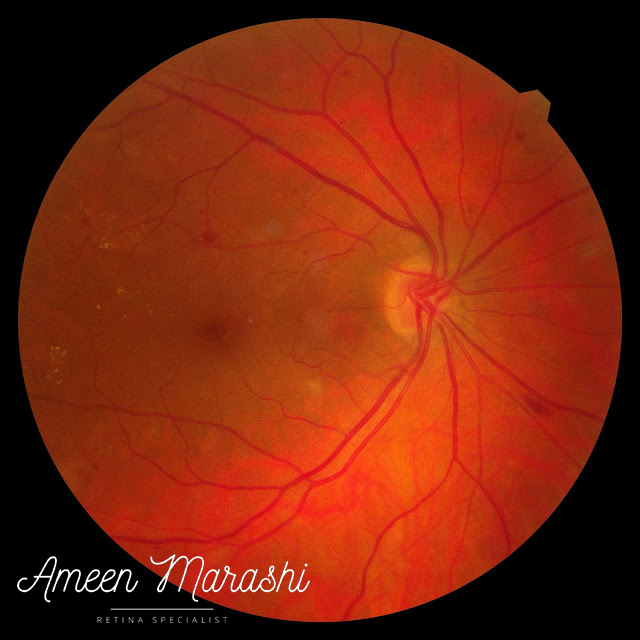A 58 years old male diabetic for ten years with BCVA 20/20 presented to me for a regular eye exam with IOP 12 mmHg.
Fundus Image
His Fundus photograph shows hard exudates far from the fovea with microaneurysms, intraretinal dot blood, and soft exudates (cotton wool spots) where the optic disc has a deep configuration (bucket like) with asymmetric orange to red color.
 |
| Fundus image of subtle NVD |
Optical Coherence Tomography
OCT scan shows normal foveal contours and thickness with the absence of diabetic macular edema.
 |
| Normal OCT scan despite leaking microaneurysms |
Fundus fluorescein angiography
FFA shows hypofluorescence in the mid retinal periphery due to hypoperfusion (ischemia) with hyperfluorescence dots and hyperfluorescence superior temporal of the optic disc; this hyperfluorescence increases and develops a leak in the mid and late stages.
 |
| Early phase of FFA showing leakage from the optic disc |
 |
| Mid phase of FFA showing leakage from the optic disc |
 |
| Late phase of FFA showing leakage from the optic disc |
Diagnosis
Early PDR with NO diabetic macular edema
Management
Pan Retinal Laser photocoagulation (PRP) in 2 sessions two weeks apart
Discussion
This eye has reached the state of relative ischemia, as shown in FFA in the form of peripheral hypofluorescence. Despite the leaking microaneurysms in the macula, there is no diabetic macular edema.
However, the early hyperfluorescence and leakage from the optic disc show small neovascularization (NVD) that was subtle in fundus photography. NVD is small in size with a bucket configuration of the optic disc.
The PRP was chosen as mainstay treatment in two sessions two weeks apart as there is no diabetic macular edema and not to induce macular edema. However, OCT follow-up is mandatory.
Take-home messages
1) When we see hard exudates or leaking microaneurysms on FFA, that does not mean there is diabetic macular edema
2) OCT is the gold standard to diagnose diabetic macular edema
3) FFA can help us diagnose ischemic changes and subtle neovascularization even when the fundus looks quite like this case
Comments
Post a Comment